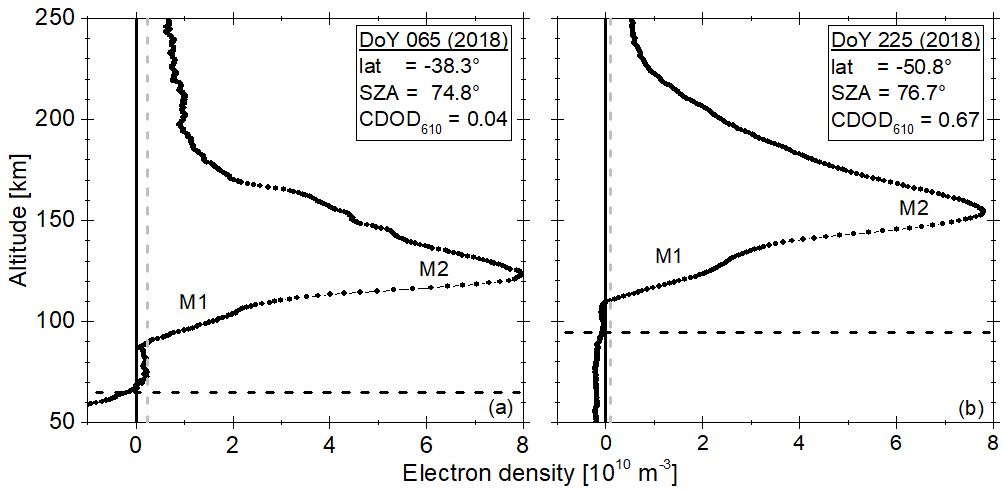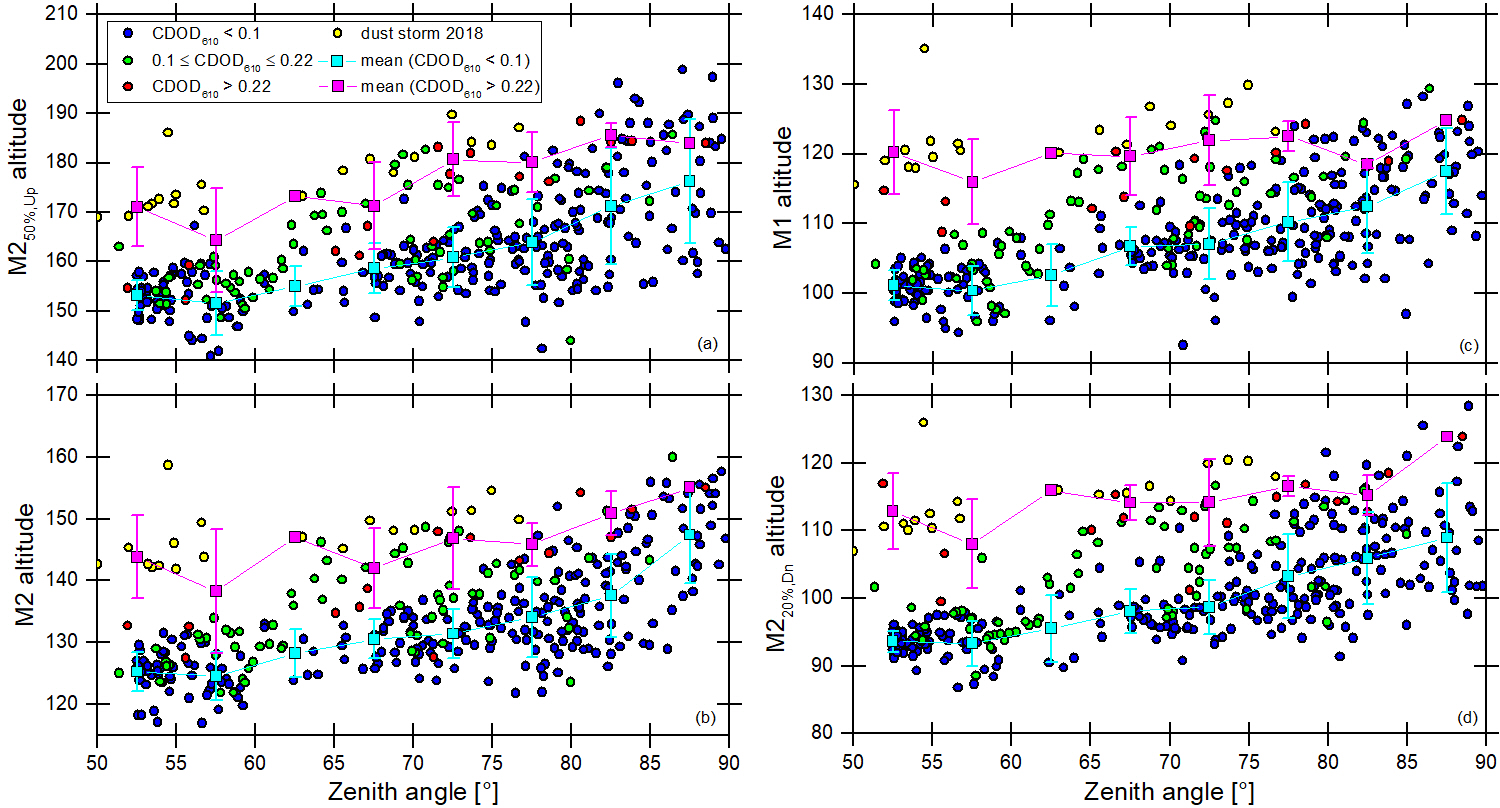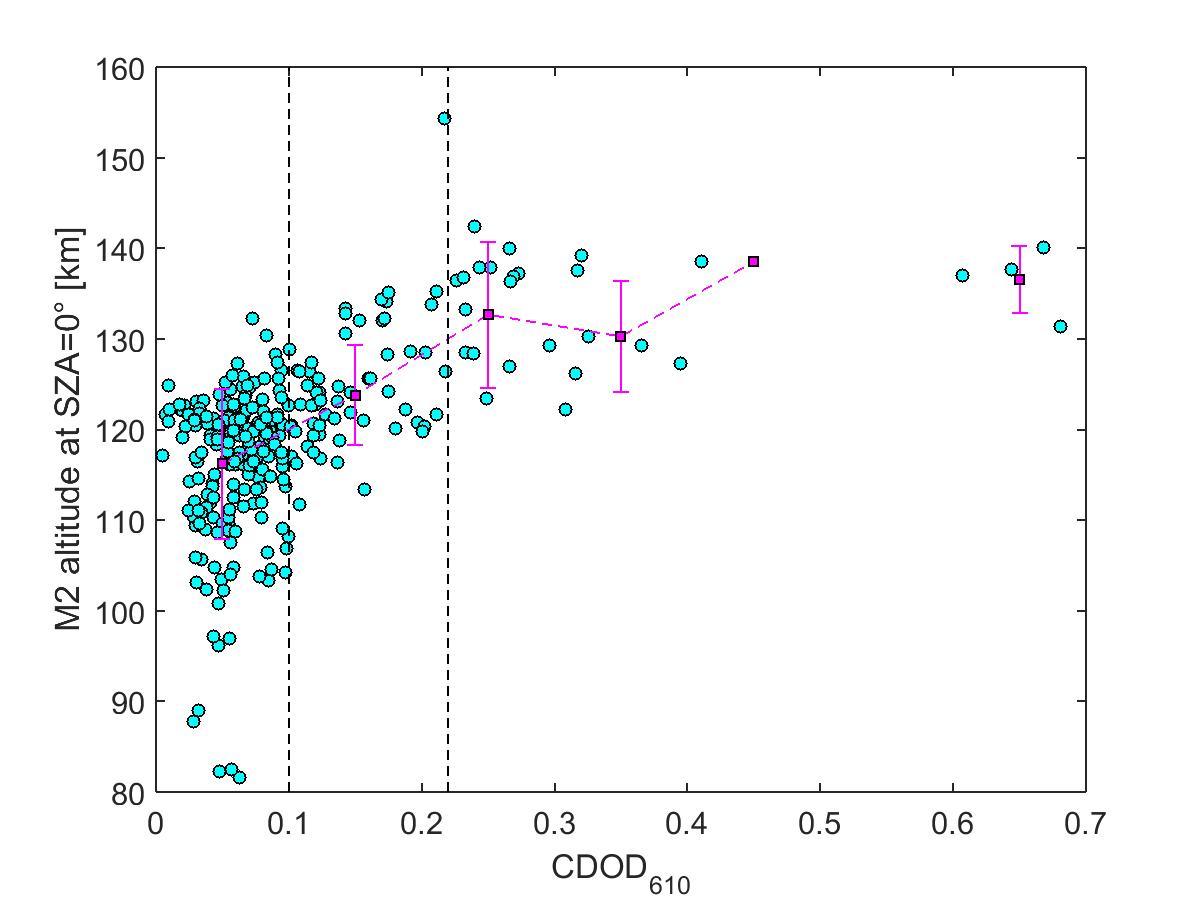- 1Rhenish Institute for Environmental Research, Cologne, Germany, (Kerstin.peter@uni-koeln.de)
- 2Laboratoire de Météorologie Dynamique, Sorbonne Université Paris, France
- 3Space Science Institute, Boulder, CO, USA (lmontabone@spacescience.org)
- 4Laboratory for Atmospheric and Space Physics, University of Colorado at Boulder, Colorado, USA (Ed.Thiemann@lasp.colorado.edu)
- 5Research and Scientific Support Department of ESA, ESTEC, Noordwijk, The Netherlands (owitasse@cosmos.esa.int)
- 6Argelander Institut für Astronomie, Bonn, Germany (mbird@astro.uni-bonn.de)
Since December 2003, when the Mars Express spacecraft entered Mars orbit, the Mars Express Radio Science experiment (MaRS) has recorded more than 1,000 high-resolution height profiles of the Mars ionospheric electron density from the topside down to the ionospheric base [1]. The two dominant features of the undisturbed Martian dayside ionosphere are the main peak region (M2), which is mainly caused by solar radiation in the Extreme Ultraviolet and the secondary layer (M1), which is produced mostly by the primary and secondary impact ionization of short solar X-rays < 10 nm [2].
Dust interacts strongly with the Mars atmospheric circulation. Observed dust-associated effects range from local to regional and upward to planet encircling global dust storms. Previous observations indicated a rise of the main ionospheric region during dust storms from local heating of the neutral atmosphere by the absorption of solar radiation (e.g. [3, 4, 5]). An increase in the height of the ionospheric main peak was also observed by MaRS during the 2018 global dust storm (Figure 1). While the observation in Figure 1a was conducted before the onset of the global dust storm, the observation presented in Figure 1b was conducted during the storm’s declining phase. The altitude increase of the entire ionospheric photochemical region by ~31 km from DoY 065 to DoY 225 correlates well with a large increase in atmospheric dust content.

Figure 1: Dayside ionosphere of Mars observed by MaRS on (a) Day of Year (DoY) 065 (2018) before the beginning and (b) DoY 225 (2018) during the declining phase of the 2018 global dust storm. The gray dashed line indicates the noise level; the black dash-dotted line marks the lowest valid altitude of the individual observation (details in [1]).
This work combines 17 years of MaRS ionospheric dayside measurements with observations of environmental parameters describing the solar flux and atmospheric dust content to investigate the effect of the varying atmospheric dust on the Mars dayside ionosphere during local/regional dust events and the 2018 global dust storm. A total of 361 MaRS height profiles of the ionospheric dayside with low observational noise level were selected for this study. The solar flux for each observation is either derived from the MAVEN EUVM based Flare Irradiance Spectral Model for Mars (FISM-M, [6]) or the Earth FISM V2 [7] model calibrated for the Mars position. Individual dust parameters (column dust optical depth – CODO610: infrared 9.3 mm absorption values normalized to 610 Pa) were derived for each observation from the gridded and kriged Martian dust maps of Montabone et al. [8, 9]. CDOD610 varies between 0.01 and 0.68 in the MaRS data set.
The raising effect of the atmospheric dust content on the main ionospheric region is statistically confirmed in the MaRS data set (Figure 2b). In addition, it is found that the dust’s raising effect actually affects the entire photochemical region of the Martian ionosphere, including the base (Figure 2d), the M1 region (Figure 2c), and the region above the main peak where the electron density reaches 50% of the main peak electron density (Figure 2a).

Figure 2: Altitudes of (a) 50% M2 electron density above the main peak, (b) M2 main peak, (c) M1 peak and (d) 20% M2 electron density below the main peak in dependence of SZA and CDOD610. Cyan squares/error bars indicate the mean and standard deviation of the low CDOD610 MaRS observations in each 5° SZA bin, while magenta squares/error bars indicate those of the high CDOD610 MaRS observations.
Figure 3 illustrates the M2 peak altitude at a solar zenith angle (SZA) of 0° as a function of the CDOD610 distribution, derived by applying a Chapman fit to the main peak region of each individual ionospheric profile. The altitude distribution of M2 at SZA=0° as a function of the associated CDOD610 indicates a saturation of the dust raising effect for CDOD610 > 0.22.

Figure 3: Derived M2 altitude for SZA=0°. Magenta squares and error bars indicate the mean and standard deviation in each 0.1 CDOD610 bin.
References
[1] Peter et al. (2021), Icarus, 359.
[2] Fox et al. (1996), Adv. Space Res., 17, 11.
[3] Wang and Nielsen (2003), PSS, 51, 4-5.
[4] Girazian et al. (2019), JGR Planets, 124.
[5] Felici et al. (2020), JGR Space Physics, 125.
[6] Thiemann et al. (2017), JGR Space Physics, 122.
[7] Chamberlin et al. (2020), Space Weather, 18, 12.
[8] Montabone et al. (2015), Icarus, 251.
[9] Montabone et al. (2020), JGR Planets, 125.
How to cite: Peter, K., Pätzold, M., Montabone, L., Thiemann, E., Witasse, O., Tellmann, S., and Bird, M. K.: The effect of atmospheric dust on the Mars dayside ionosphere derived from 17 years of Mars Express Radio Science observations, Europlanet Science Congress 2021, online, 13–24 Sep 2021, EPSC2021-485, https://doi.org/10.5194/epsc2021-485, 2021.

